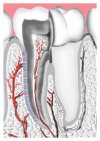The role of hypoxia in orthodontic tooth movement
- PMID: 24228034
- PMCID: PMC3818850
- DOI: 10.1155/2013/841840
The role of hypoxia in orthodontic tooth movement
Abstract
Orthodontic forces are known to have various effects on the alveolar process, such as cell deformation, inflammation, and circulatory disturbances. Each of these conditions affecting cell differentiation, cell repair, and cell migration, is driven by numerous molecular and inflammatory mediators. As a result, bone remodeling is induced, facilitating orthodontic tooth movement. However, orthodontic forces not only have cellular effects but also induce vascular changes. Orthodontic forces are known to occlude periodontal ligament vessels on the pressure side of the dental root, decreasing the blood perfusion of the tissue. This condition is accompanied by hypoxia, which is known to either affect cell proliferation or induce apoptosis, depending on the oxygen gradient. Because upregulated tissue proliferation rates are often accompanied by angiogenesis, hypoxia may be assumed to fundamentally contribute to bone remodeling processes during orthodontic treatment.
Figures
References
-
- Rohen JW. Anatomie für Zahnmediziner. 1994.
-
- Basdra E. Biologische Auswirkungen der kieferorthopädischen Zahnbewegung. Journal of Orofacial Orthopedics/Fortschritte der Kieferorthopädie. 1997;58:3–15. - PubMed
-
- Lekic P, McCulloch CAG. Periodontal ligament cell populations: the central role of fibroblasts in creating a unique tissue. Anatomical Record. 1996;245:327–341. - PubMed
-
- Göz G. Praxis Der Zahnheilkunde—Kieferorthopädie 2. 4., 27-45. München, Germany: Urban – Fischer; 2000. (Edited by: Diedrich, P., Heidemann, D., Horch, H.H., Koeck, B.).
-
- Takano-Yamamoto T, Takemura T, Kitamura Y, Nomura S. Site-specific expression of mRNAs for osteonectin, osteocalcin, and osteopontin revealed by in situ hybridization in rat periodontal ligament during physiological tooth movement. Journal of Histochemistry and Cytochemistry. 1994;42(7):885–896. - PubMed
Publication types
LinkOut - more resources
Full Text Sources
Other Literature Sources
Research Materials



